Rosewill Blackhawk Ultra Case Review: Were It Not For Competition
by Dustin Sklavos on March 28, 2013 12:01 AM EST- Posted in
- Cases/Cooling/PSUs
- Rosewill
- HPTX
- ATX
- XL-ATX
Noise and Thermal Testing
When I saw the Rosewill Blackhawk Ultra lacked a fan controller, I immediately became much more skeptical about its performance. Thermally it should do a stellar job, but with no way to modulate fan noise, Rosewill basically has to count on the fans being quiet at stock. An integrated fan controller is practically essential at this price point, so they have to make up a lot of ground to be competitive.
Unfortunately things get a bit worse here, too. The Phantom 630 (which earned our Bronze Editor's Choice) is sitting at the exact same price point, and if you're not running bigger than XL-ATX, NZXT's vastly more feature rich enclosure may prove to be a very difficult competitor to beat.
Ambient temperatures during testing were almost 22C on the dot.

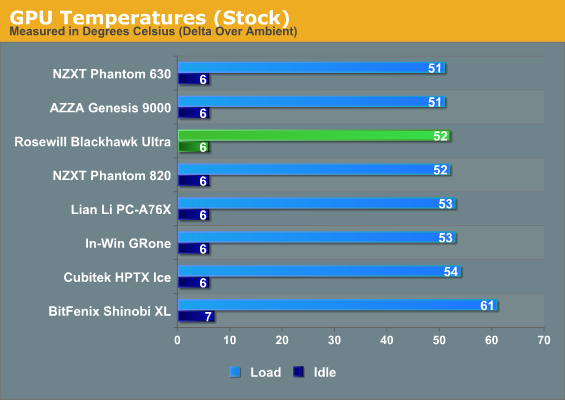
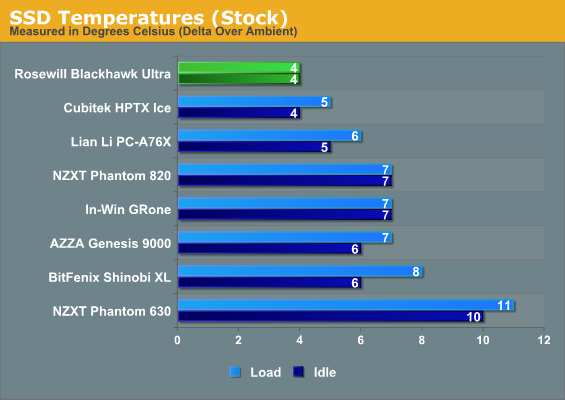
At our stock settings, Rosewill's offering is at least able to put up the thermal performance it needs to in order to be competitive. It's unlikely anyone using this case will run their hardware at stock, but it's good to know the cooling capacity is definitely accounted for.
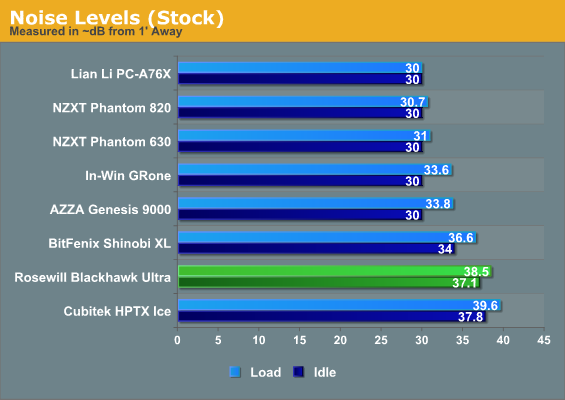
Unfortunately, noise levels turn out to be a real issue. In the Blackhawk Ultra's defense, while the measured 37.1 dB of idle noise is pretty loud, the character of the noise is actually pretty tolerable. It's very low-pitched due to the size of the fans used; the case essentially sounds like a box of low wind. NZXT's Phantom 630 runs a lot quieter, though, with only a minor three degree uptick in CPU temperatues.
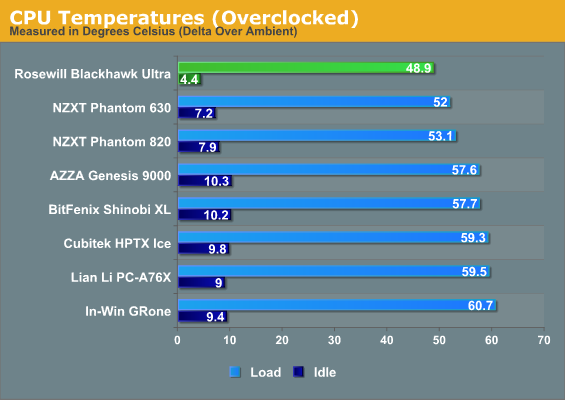

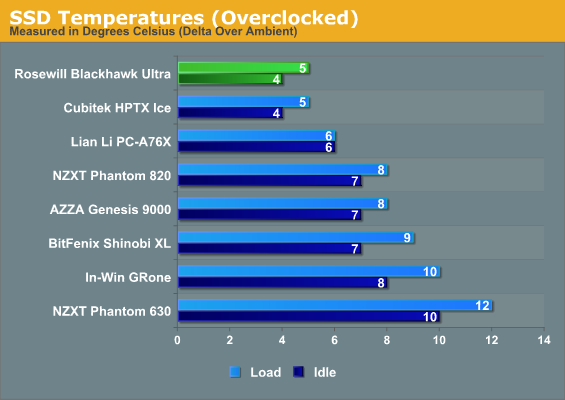
Overclock the system and temperatures begin to compress a little, but Rosewill also continues to perform near the top.
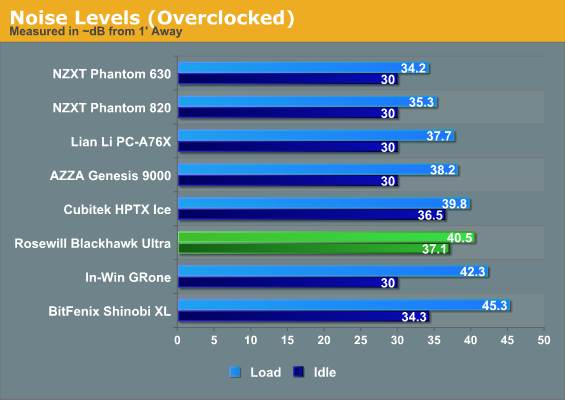
Despite its excellent airflow, though, Rosewill just can't keep the noise levels down. A large part of that is simply due to the fact that the case's noise floor is 37.1 dB, loud enough to drown out most of the other components in the first place.
Unfortunately I don't have results for the NZXT Phantom 630 in our full fat testbed, where I do think the Blackhawk Ultra promises to acquit itself better. The only cases I've tested so far with that testbed are in different price brackets, but this should at least illuminate why spending more on a case isn't a bad idea if you're going for a high end build.
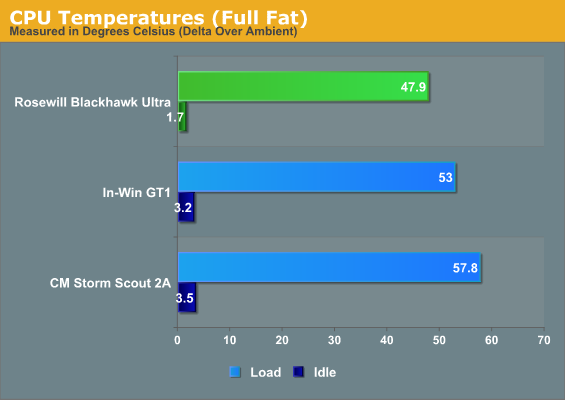
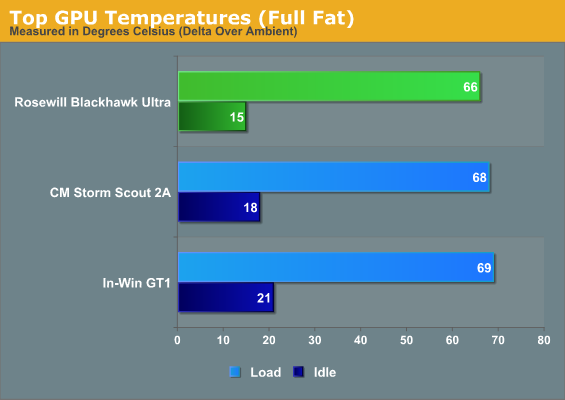

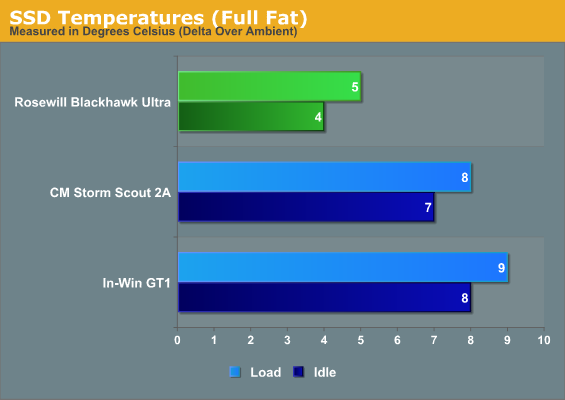
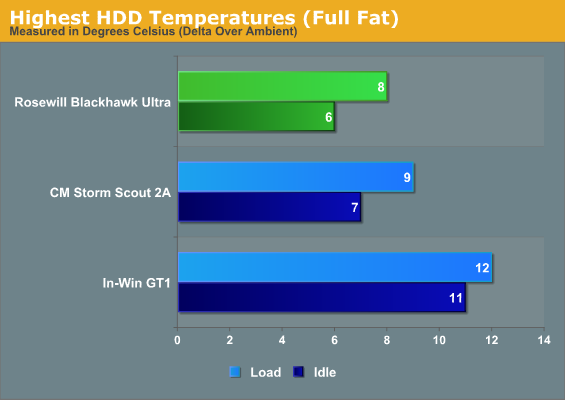
Rosewill's case gets you a not-inconsiderable five degree delta over the In-Win GT1 on the CPU, and GPU thermals are also down by a couple of degrees. In an SLI configuration, the GeForces are going to be pushing their fans to hit a target temperature of 88-90C, so thermals in that instance won't be as telling as noise levels will be.
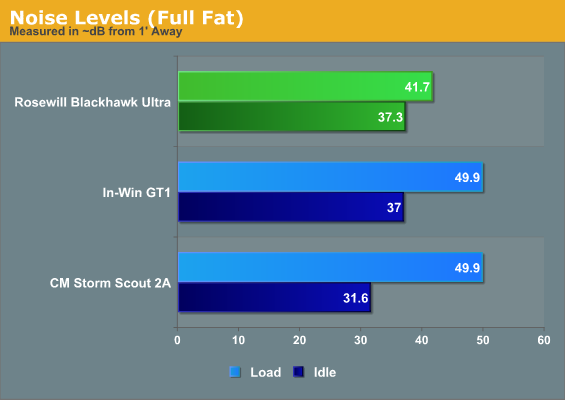
And here's Rosewill's ace in the hole. While idle noise is still unpleasant, load noise is worlds better than the competing cases. This is why you buy an enthusiast class case for a high end build; the superior airflow keeps the fans on the GeForces from having to go at full tilt, and as a result, the noise level is actually comparatively tolerable.










27 Comments
View All Comments
GUYFIERI - Thursday, March 28, 2013 - link
Whats wrong with the title?epoon2 - Thursday, March 28, 2013 - link
it's all in the last page:given the price, there are other products which optimized for both noise & cooling
lever_age - Thursday, March 28, 2013 - link
I wonder what that top middle fan mount does other than (1) ensure that a conspicuous meshed area has a fan behind it, (2) light up, and (3) steal air from the CPU cooler. Maybe it helps the graphics cards in some setups? Possibly? Or it's just the aesthetics and we-crammed-three-230mm-fans-in-a-case appeal.ShieTar - Thursday, March 28, 2013 - link
Not sure which one of the two you think is the "middle" one, but either way it is an exhaust fan. To take air away from the CPU cooler after it has been pushed through there and heated up is exactly what it is there for.DanNeely - Thursday, March 28, 2013 - link
I suspect it's the forward fan on the top (since there's a fair amount of case forward of it). As it is it's probably aimed toward maxing out total airflow.Having that much space to install fans OTOH does fit one major feature checkbox; it makes this one of the very few cases able to fit a 3x140mm radiator without being modded. The only others I know of are from MountainMods and CaseLabs; both of whose cases are significantly more expensive.
BMAN61 - Friday, March 29, 2013 - link
There are 2 other chassis with native support for a triple 140mm radiator; namely the NZXT Switch 810, and their other offering the Phantom 820.So no need to spend megabucks for a chassis from CaseLabs or Mountain Mods.
lever_age - Thursday, March 28, 2013 - link
Sorry, I meant the 230mm top fan (the one halfway between the front and back of the case, not the one toward the rear that's above the motherboard).With a typical ATX layout with say two 120mm / 140mm fan positions on top, it sometimes doesn't help (sometimes even hurts) to have the second one, the one towards the middle of the case. If used as exhaust, it takes air away from the intake of a side-blowing tower CPU cooler as we have here. If used as intake right next to the other top fan (and exhaust), that creates turbulence and doesn't work too well unless you actually add ducting to the CPU cooler intake.
Here, the position of the second top fan looks ridiculous because the two are so large. That said, because of the size of the case, distance to the CPU intake area is not that small. Having the mesh, cutout, and space for a 3x140mm radiator is nice, but that doesn't mean that putting a second fan there actually helps anything (other than arguably aesthetics and checkbox on the feature list, which would be my guess).
Seems like it could be a situation where marketing trumps engineering, which is what I was getting at. We have airflow for the sake of airflow, rather than directing air to useful places.
RosewillEye - Thursday, May 30, 2013 - link
One can never have too many fans.HobgoblinX - Thursday, March 28, 2013 - link
As usual, I really enjoy reading your reviews. Great detail. Great humor. I just have one question. Could you please re-test the Thor V2? You changed your test bed very shortly after reviewing the Thor V2, and it's a little frustrating to have a case referenced in numerous reviews that I cannot compare to the case under review because the Thor V2 has no compatible numbers.Ilias78 - Thursday, March 28, 2013 - link
And as always, Dustin complains about cable management. Yet he does the worst cable management in the business - regardless the case or the review.